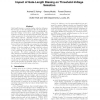Free Online Productivity Tools
i2Speak
i2Symbol
i2OCR
iTex2Img
iWeb2Print
iWeb2Shot
i2Type
iPdf2Split
iPdf2Merge
i2Bopomofo
i2Arabic
i2Style
i2Image
i2PDF
iLatex2Rtf
Sci2ools
88
Voted
ISQED
2006
IEEE
2006
IEEE
Impact of Gate-Length Biasing on Threshold-Voltage Selection
Gate-length biasing is a runtime leakage reduction technique that leverages on the short-channel effect by marginally increasing the gate-length of MOS devices to significantly reduce their leakage current for a small delay penalty. The technique was shown to work effectively with multi- thresholdvoltage assignment, the only mainstream approach for runtime leakage reduction. Typically, designers use threshold voltages selected by the foundries to optimize their designs. Higher threshold-voltage devices, that are less leaky but slow, are assigned to non-critical paths and lower threshold-voltage devices, that are fast but leaky, are assigned to critical paths. In this paper we study the effect of modifying threshold voltages set by the foundry on leakage reduction achieved on three large, real-world designs. We assess the impact of the availability of gate-length biasing on threshold voltage selection. We achieve comparable leakage reductions when foundry-set dual threshold voltage...
| Added | 12 Jun 2010 |
| Updated | 12 Jun 2010 |
| Type | Conference |
| Year | 2006 |
| Where | ISQED |
| Authors | Andrew B. Kahng, Swamy Muddu, Puneet Sharma |
Comments (0)

